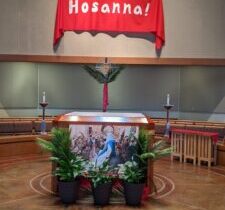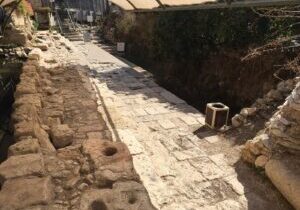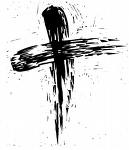Recognizing the Lord when He Comes
 Holy Week begins. This is the most important week in our entire year as Christians. The mystery of reconciliation of humans and the divine plays out graphically in the events we celebrate this week.
Holy Week begins. This is the most important week in our entire year as Christians. The mystery of reconciliation of humans and the divine plays out graphically in the events we celebrate this week.
Sunday of Holy Week is known as Palm Sunday of the Lord’s Passion. Traditionally, we begin our liturgy outside the church building. We gather with palms around our presider and hear the proclamation of the Gospel which tells of Jesus’ triumphal entry into Jerusalem a few days before his arrest. Following the reading, we process into the building and continue with our liturgy, formally opening this week of prayer and celebration of the mystery in which we participate.
The Gospel reading for the blessing of the palms will be from one of the Synoptic Gospels – the three oldest versions of the events of Jesus’ life – as narrated by Matthew, Mark, and Luke. In Cycle C (which we celebrate in 2022), it is Luke’s account that we will hear.
These accounts all tell of Jesus coming into the city riding a young donkey. Kings and conquering military heroes of his day rode into cities mounted on great war horses, with banners flying, triumphal music playing, and crowds of grateful (or at least cheering) people to welcome them. Coming into town, riding a steed, and attracting a crowd of cheering people speaks to the Jewish dream of a Messiah in those times, a hero who will rescue the nation from captivity to a conquering nation (Rome). This was the kind of hero long-awaited – the kind many hoped Jesus would be.
Jesus, however, came riding a young donkey. One version says it had never been previously ridden by anyone. This is an important detail. In the prophecies of Zechariah, written almost 500 years earlier, there was a statement that the Messiah would come riding a donkey, just as had princes and leaders from before the period of kings in Israel. This person would be a leader who was humble and would bring peace. He would not be a warrior or a conquering hero. The symbolism of this entry riding on a young donkey would not have been lost on the people welcoming Jesus, nor was it lost on the authorities. In fact, they asked him to tell the people to be quiet and go away. They were quite likely afraid of the potential negative Roman response to the commotion. Jesus’ response was that even if the people went away, the very stones would shout out against the injustice of the social structure.
Another detail of interest in Luke’s telling of the tale is the question of palm branches. In Luke’s version of the story, there is no mention of palm branches or fronds having been waved in greeting or salute to Jesus. Palms are there in the other three gospels, but not in Luke.
In Luke, as in the others, the fact that people lay their cloaks out to make a road and that Jesus sat on cloaks that had been placed on the back of the donkey is noted. A cloak was a very valuable possession in those days. It was an outer garment that served as coat when the weather was cold and as a sleeping bag at night, especially for those who were not inside a building for the night. Ordinary folks were putting their coats on the ground for the donkey and any following closely behind to trod. That’s a pretty major commitment. I’m glad I didn’t have to pick my coat up and sleep in it after having a donkey and a large crowd of people walk over it!
Once inside the walls of Jerusalem, Jesus went to the temple. Matthew, Mark, and Luke all tell that Jesus disrupted the markets in the temple, chasing out the money-changers and others who were cheating the poor. He spent time teaching there as well, presumably not immediately after shaking everything up! The point is, he was not a quiet, meek, “what-ever” kind of guy. He had a vision and a mission. He was passionate about following the spirit of the Law and living what he had preached in the years leading to this visit to Jerusalem. He was not a person who could be ignored.
The first and second readings on Palm Sunday of the Lord’s Passion are the same every year, as is the Psalm. Our attention is drawn to the events that followed Jesus’ triumphal entry into Jerusalem.
The first reading is from Isaiah (50:4-7), the Suffering Servant’s declaration of his determination to speak words of hope and encouragement to the people, despite opposition and persecution against him. This is a proclamation of great hope in the face of overwhelmingly negative odds. The prophet declares, “I have set my face like flint, knowing that I shall not be put to shame.”
Psalm 22 is the one Jesus prayed on the cross. The psalms were much like our traditional “prayers” such as the Hail Mary or Our Father. These were prayers that could be offered any time and at any place by anyone. There’s a psalm for just about every situation in life. “My God, my God, why have you abandoned me?” A cry for help when in desperate straits, with a conclusion that declares a joyful recognition of the Lord’s power to overcome all – “I will proclaim your name to my brethren; in the midst of the assembly I will praise you.”
Paul’s letter to the Philippians (2:6-11) includes another ancient hymn. Modern musicians have put it to music for our communities too, celebrating the great mystery of the incarnation. Jesus did not hesitate to become one of us and experience all that we experience, including rejection and death. God raised him up and gave him a name (power and authority) above all others. This is one of the earliest proclamations of our belief – “Jesus Christ is Lord, to the glory of God the Father.”
St. Luke’s telling of the Passion and Death of Jesus is the Gospel reading for Cycle C. It is a powerful story that begins with the narrative of the Last Supper and the gift of Jesus’ body and blood for our Eucharistic celebrations. It continues through the agony in the garden, Jesus’ trial, condemnation, carrying of the cross, and execution. His words of forgiveness and his prayers on the cross speak to us. We close with the quiet sorrow of his death and hasty burial in a borrowed tomb.
We are not called to be saddened by all of this. It is to be a source of great hope, but a hope that is so outrageously improbable and powerful that we are in awe of it. We enter this week with quiet hope for our own lives and the world in which we live. We pray for insight and the ability to see the Lord’s presence in all the times and ways he comes into our lives.
This can be a very busy week. There are liturgies and preparations for Easter. Work and school don’t necessarily take the time off. Yet it is a solemn time too. Liturgies for the blessing of the Holy Oils, Holy Thursday and Good Friday services, Easter Vigil, and then the great feast of Easter all await.
How will I mark this time? What things can wait, what need attention? What do I normally neglect that maybe I should spend some time doing?
May these final days of preparation for Easter be ones of peace and quiet joy, as we trust that through all the ups and downs of life, our God is with us, loving and supporting us each step along the way. Hosanna in the Highest.
Here are links to sample a couple of versions of the song from the Philippians that St. Paul shared with us.
In English, from Ken Canedo
In Spanish, from Pedro Rubalcava

































